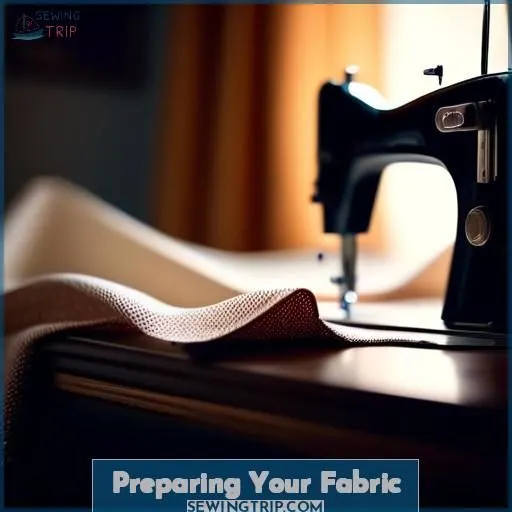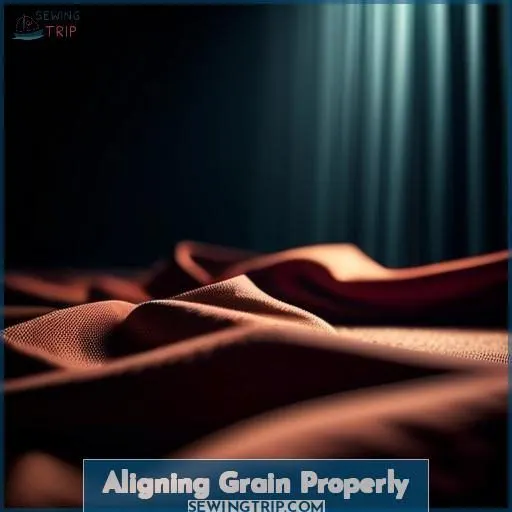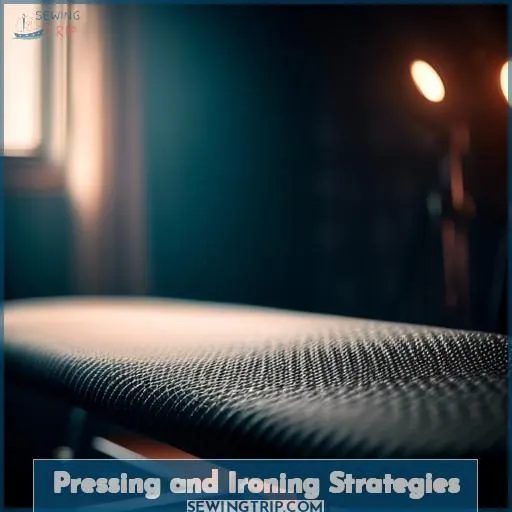This site is supported by our readers. We may earn a commission, at no cost to you, if you purchase through links.

To sew large pieces of fabric, start by preparing your fabric. Measure and mark the fabric, then prewash it with Synthrapol soap. Fold the fabric for cutting, making sure the selvedge edges do not touch.
Align the grain properly by identifying the warp and weft. Fold the fabric selvedge to selvedge and check the grain alignment.
When cutting, fold the fabric to fit the cutting mat. Measure twice before cutting, and handle the selvedges carefully.
Sew large fabric sections by rolling the fabric on either side of the seam. Use a walking foot and maintain fabric stability.
Hem and finish the edges with a double roll hem. Sew it in place and make sure it’s straight and even.
Consider Shibori dyeing methods and pressing and ironing strategies for more techniques.
The key to sewing large pieces of fabric is patience and precision.
Table Of Contents
Key Takeaways
- Preparing your fabric is crucial, involving measuring, marking, pre-washing with Synthrapol soap, and ensuring the fabric is properly dried and folded for cutting.
- Accurate grain alignment is essential for sewing large pieces of fabric, requiring identification of the warp and weft, straightening selvedge edges, and checking grain alignment before cutting.
- When sewing, managing large fabric sections can be facilitated by rolling the fabric on either side of the seam, using a walking foot for even feeding, and employing specific sewing techniques to maintain fabric stability.
- Finishing techniques, such as hemming with a double-roll hem and considering Shibori dyeing methods, can enhance the final appearance of your project, while pressing and ironing strategies ensure the fabric is smooth and ready for sewing.
How to Sew Large Pieces of Fabric?
To sew large pieces of fabric, follow these tips:
- Press all hems into place and check for straightness before sewing.
- Use a washout sewing marker and a t-square to draw lines on your fabric and find the straight of grain.
- Measure and mark on a clean floor, and roll your fabric evenly on either side of the seam before sewing.
- Sew parallel seams (quarter inch apart) on the same side, in the same direction, and baste the sections to avoid marring the fabric.
- Use a walking foot if you have one, as it’s favored by sailmakers.
- Fold the fabric without the selvedge edges touching to find the straight of grain.
- Work with the fabric to make sure the fold is straight when refolding.
- Use steam to soften the fabric fibers and then flatten the seams.
- Consider grading the seam allowances at different lengths to reduce bulk.
- Use a rubber mallet or a tailor’s clapper to flatten the seams, but protect your fabric with another layer.
- Use clips instead of pins to avoid bulkiness.
- Use the right size needle for thicker fabrics or multiple layers.
- Practice on scraps to find the correct tension settings.
- Increase the stitch length and use a walking foot to help with difficult areas.
- Sew slowly over difficult areas and use the hand wheel to manually sew if needed.
- If you don’t have a walking foot, use a small stack of scrap fabric to level the foot.
- Cut or grade the seam allowance down and do the top stitch further away than normal to avoid going through all the seam allowance.
- If your machine is still having trouble, sew as much as you can using your sewing machine and then sew the problem areas by hand.
Preparing Your Fabric
To prepare your fabric for sewing large pieces, start by measuring and marking on a clean floor using a measuring tape and yard stick.
Prewash your fabric using Synthrapol soap, setting your washing machine to extra rinse and warm wash with cool rinse. Dry the fabric on a warm setting for 15 minutes.
Finally, fold the fabric for cutting without selvedge edges touching and measure twice before cutting.
Measuring and Marking
To measure and mark your fabric, start by selecting the right tools. Use a measuring tape and yard stick for accurate measurements. Mark your fabric with chalk or fabric markers. Use a ruler or straight edge for straight lines. Make sure your measurements are precise before cutting.
When marking on a clean floor, remember to use a yard stick and a measuring tape. Always double-check your measurements for accuracy.
Prewashing Techniques
Pre-washing your fabric before sewing is a vital step to guarantee the most satisfactory outcomes. Natural fibers such as cotton, linen, and rayon should invariably be pre-washed since they’re disposed to shrinking. Synthetic fabrics should also be pre-washed to verify for color bleeding. Consistently adhere to the fabric care label and employ a mild detergent to prevent skin irritations.
To safeguard fabric from fraying during pre-washing, serge or zig-zag the borders of the fabric. Wash the fabric on a gentle cycle, employing the same technique as you intend to use for the finished garment. If you’re utilizing a washing machine, set it to the most delicate cycle, preferably the delicate setting. If washing by hand, fully immerse the fabric in water and gently squeeze to remove air bubbles.
Pre-washing saves time in the long run by precluding the necessity for substantial alterations after the initial wash. It also guarantees that your garment will maintain its appearance after the first wash, as numerous fabrics shrink substantially during the first wash.
Bear in mind to pre-wash all fabrics constructed from natural fibers, and contemplate pre-washing synthetic fabrics as well. Always consult the fabric care label for washing instructions prior to pre-washing.
Drying and Folding for Cutting
To prepare your fabric for cutting, it’s crucial to dry and fold it properly. Drying your fabric guarantees that it’s ready for cutting without any shrinkage or distortion. Once dry, fold your fabric to fit your cutting mat or board, making sure that the selvedge edges remain separate. This helps maintain the fabric’s integrity and prevents any unwanted stretching or distortion.
When folding, be sure to press the fabric to eliminate any wrinkles or creases. You can use an ironing board and steam iron for this. Fold the fabric narrower than the ironing board length to iron the center section without causing creases or folds. Reposition the fabric and continue ironing until the entire piece is smooth and ready for cutting.
Remember to use a cutting mat or board to protect your work surface and ensure accurate cuts. When cutting large pieces of fabric, measure twice before cutting to avoid any mistakes. Handling and cutting selvedges carefully can also help prevent any issues during the cutting process.
Aligning Grain Properly
To align the grain precisely when sewing large fabric pieces, it’s imperative to pinpoint the warp and weft of the fabric. The warp runs parallel to the selvage edge, while the weft runs perpendicular to it. Straightening the selvedge edges is also essential, as they can become skewed during fabric processing.
To verify the grain alignment, fold the fabric selvedge to selvedge and smooth it out. If the fabric isn’t aligned, pull the corners to rectify the alignment and repeat the process until the fabric is correctly aligned.
The resulting cut will be precise to the desired measurements if the fabric is kept flat, unwrinkled, and on the grain.
Identifying Warp and Weft
To align the warp and weft in your fabric effectively, it’s essential to determine the weave and measure the fabric bias. Begin by identifying the weft direction, which is usually horizontal. Then, align the warp and weft to make sure the fabric is on the straight of grain. This will help you cut and sew large pieces of fabric accurately.
Straightening Selvedge Edges
Guarantee accurate measurements and alignment of your fabric by following these steps:
- Straighten Selvedge Edges: Before cutting, verify that your selvedge edges are straight. If they’re uneven, use a ruler or straight edge to align them. This will help maintain the integrity of the fabric and prevent distortion during cutting and sewing.
- Check Grain Alignment: Before cutting, inspect that your fabric is on the grain. This means the warp and weft threads are running parallel to the selvages. If the grain is off, it can cause your fabric to twist or stretch out of shape. To examine, fold your fabric in half along the selvages, and if it squares up, you’re on the grain.
- Pin and Cut: Once your selvedge edges are straight and your fabric is on the grain, attach the fabric along the seamline to keep it flat and taut. Then, use a rotary cutter or a sharp pair of scissors to cut along the marked line. Be sure to measure twice before cutting to guarantee accuracy.
- Fold and Cut: If your fabric is wider than your cutting mat, reduce it to fit before cutting. Fold it in half along the grainline, then unfold it and cut along the doubled edge. This will help you cut more efficiently and accurately.
- Handling Large Fabric: When working with large fabric pieces, it’s imperative to handle them carefully to avoid distortion. Fold them to a manageable size before cutting, and use a walking foot or other sewing technique to guarantee uniform feeding. Remember to keep your fabric flat, uncreased, and on grain to achieve the best results.
Checking Grain Alignment
To guarantee accurate grain alignment when working with fabric, follow these steps:
- Unravel a thread from the weave along ripped edges**: This helps you identify the direction of the warp and weft threads in the fabric.
- Fold fabric selvedge to selvedge and smooth**: This will help you align the fabric correctly.
- Pull corners to correct grain alignment**: Gently pull the corners of the fabric to align them with the warp and weft threads.
- Repeat folding and pulling until fabric is on the grain**: Keep folding and aligning until the fabric is properly aligned with the warp and weft threads.
- Check grain alignment by folding fabric again: Fold the fabric in half along the grain line to confirm** it’s properly aligned.
Cutting Large Fabric Pieces
To cut large pieces of fabric accurately, you can fold the fabric to make it more manageable. This can be done once or twice, depending on the type of fabric. Make sure your fabric is freshly pressed to avoid wrinkles when folding.
Fold the fabric once for a lengthwise cut and then fold it the other way for a widthwise cut. This will help you achieve straight cuts without the need for a large cutting mat.
Folding Fabric to Fit Cutting Mat
To fold fabric to fit your cutting mat and optimize your work surface for large fabric handling, follow these steps:
- Measure twice: Before folding the fabric, make sure you have precise measurements to prevent any mistakes in cutting.
- Choose the right fold: Fold the fabric in a way that allows it to fit on the cutting mat without any wrinkles or creases. This may involve folding it in half or using an alternative folding method.
- Use a cutting guide: If your mat isn’t wide enough, you can use a cutting guide to extend the cutting surface. This could be a ruler, a piece of cardboard, or even a large piece of paper.
- Secure the fabric: Use clips, pins, or weights to keep the fabric in place while cutting. This will prevent it from shifting or moving, ensuring precise cuts.
- Use a straight edge: For straight cuts, use a straight edge or ruler to guide your cutting. This will help maintain the accuracy of your cuts.
Measuring Twice Before Cutting
To guarantee accurate measurements when cutting large fabric pieces, it’s essential to measure twice before cutting. This practice aids in avoiding errors and guarantees precision in your project. Here are some tips for measuring precisely:
- Use appropriate tools: Utilize a solid ruler or yardstick for long measurements, as cloth tapes can be inaccurate for extended lengths.
- Align and straighten the fabric: Before measuring, align and straighten the fabric by eliminating any folds or wrinkles, which can impact the precision of your measurements.
- Flatten the fabric: Flatten the fabric before measuring and cutting to remove any wrinkles or folds that may affect the accuracy of your cut.
- Verify the grain orientation: Ensure the fabric is aligned with the grain before measuring, as this can affect the accuracy of your cut.
- Measure twice: Double-check your measurements to guarantee they’re correct before cutting, as this can aid in preventing errors.
Handling and Cutting Selvedges
When handling and cutting selvedges, remember to verify selvedge alignment before cutting. Employ scissors with keen, pristine blades or a rotary cutter for exactitude. Preserve consistency in your cutting angles for precise dimensions.
If you’re cutting on the diagonal, utilize a rotary cutter with a ruler guide for rectilinear lines. Periodically service your scissors by cleansing and lubricating them to maintain their sharpness.
Sewing Large Fabric Sections
When sewing large fabric sections, rolling the fabric on either side of the seam can help you manage the bulk and keep everything under control. Using a walking foot for even feeding and applying specific sewing techniques will make certain your large pieces come together smoothly and look professional.
Rolling Fabric for Seam Management
Rolling fabric is a critical technique for managing seam allowances in large-scale sewing projects. Here are three essential rolling techniques to master:
- Rolling the fabric: Roll the fabric around your sewing machine‘s feed dogs to guarantee a smooth feed and prevent bulky fabrics from bunching up.
- Rolling the edges: Roll the edges of your fabric before sewing to create a neat seam and avoid any unwanted puckering or wrinkles.
- Rolling the excess: Roll up any excess fabric at the end of the seam allowance to keep your work surface tidy and prevent snags or tangles.
Using Walking Foot for Even Feeding
To guarantee consistent feeding when stitching extensive fabric sections, employ a walking foot. This foot design incorporates a tension mechanism that contributes to the equitable distribution of the fabric’s weight. Tailor the foot tension, needle type, thread thickness, and fabric density in accordance with your project.
The walking foot empowers you to stitch extensive pieces without gathering or puckering, thereby enhancing the smoothness and efficiency of your sewing process.
Sewing Techniques for Large Pieces
After mastering the walking foot‘s magic for even feeding, let’s embark on the task of sewing large fabric pieces. Maintaining fabric stability by regulating tension with precision is crucial. Handling bulk is akin to grappling with a bear, but with seam allowances as your concealed advantage.
Consider gathering fabric as corralling cats—challenging but feasible with perseverance. Recall, each stitch marks a progression in your path to sewing proficiency.
Hemming and Finishing Edges
To hem and finish large pieces of fabric, follow these steps:
Double Rolling for Quick Hems: Start by rolling the edge twice to create a quick hem. Keep the rolled edge hem roughly the same size to maintain consistency.
Sew the Hem in Place: Sew the hem in place using a straight stitch. Check twice that you’re sewing the correct side of the fabric to avoid any mistakes.
Make Sure the Hem is Straight and Even: After sewing, verify the hem for straightness and evenness. Adjust as necessary to achieve** a professional finish.
Remember to handle the fabric carefully during the hemming process to prevent any damage or distortion.
Double Rolling for Quick Hems
Double rolling for quick hems is a simple and effective technique for finishing edges. Here’s how to do it:
- Roll the edge twice: Fold the edge over once, then fold it again to create a double layer of fabric.
- Keep the rolled edge hem roughly the same size: Make sure that the folded edge is roughly the same size as the original edge to maintain a consistent hem.
- Sew the hem in place: Use a sewing machine or hand-sewing technique to secure the hem, making sure the correct side is being hemmed.
Ensuring Straight and Even Hems
To guarantee straight and even hems, follow these techniques:
- Double Rolling: Roll the edge twice to create a hem, keeping the rolled edge roughly the same size. This method is ideal for lightweight fabrics where bulk is undesirable.
- Precise Measurement: Measure the hem allowance accurately using a ruler or measuring tape. This will help you achieve a straight and even hem.
- Ensuring Alignment: Press the hem first before manipulating it further. This ensures that the hem allowance isn’t stretched, making it difficult to get an even hem.
- Ironing Techniques: Use a small puff of steam when ironing the hem to relax the fibers and collapse the hem. Then, press the hem with a dry iron to set the crease.
- Sewing Techniques: Use a walking foot for even feeding when sewing the hem. Sew slowly and evenly, stopping and correcting any problems immediately.
- Stitching: Adjust the stitch width as needed to ensure the stitch bites into the fold. This will prevent skipped stitches and ensure a straight and even hem.
To further enhance your hemming skills, consider using a sewing machine with a blind hem foot, which can nearly invisible when using a matching thread. Additionally, you can experiment with different hem styles, such as a serged hem, double fold hem, invisible hem with bonding tape, or hem tape, depending on your project and personal preferences.
Shibori Dyeing Techniques
To create stunning shibori designs, you can use various techniques like Mokume (stitched), Kanoko (bound), Itajime (folded resistance), and Dip Dyeing for effects. Each method offers its unique results, allowing you to experiment and create beautiful patterns on your fabric.
Mokume (Stitched)
To master Mokume (Stitched) Shibori dyeing techniques, you’ll need to focus on stitching techniques, thread selection, needle size, and tension adjustment. Start by marking a grid across your fabric and stitching along the rows, selvage to selvage.
Once stitched, gather the fabric by pulling on the strings and tie them off to create gathered fabric**. Dip the fabric in the dye vat and rinse, creating random bursts of color.
Vary the rubber band placement for different patterns. The goal is to create a unique, textured fabric that’s ready for your sewing project.
Kanoko (Bound)
Now that you’ve mastered Mokume (Stitched) Shibori, it’s time to explore Kanoko (Bound) Shibori. This technique involves pinching and binding fabric with rubber bands. The bound fabric is then dipped in a dye vat and untied before drying, creating random bursts of color.
For a distressed look, consider over-dyeing. Remember, the placement of rubber bands will determine the pattern. Don’t forget to add moisture with a spray bottle for even coverage.
Itajime (Folded Resistance)
To create stunning triangle patterns using the Itajime Shibori technique, follow these steps:
- Start with a piece of fabric that measures 40 x 70cm, preferably silk or a light cotton like lawn for best results.
- Rinse the fabric and fold it in half twice to create a strip measuring 10 x 70cm.
- Fold the fabric into either a square or a wedge, turning it over between each fold to create an accordion-like effect.
- Attach one or several clamps to the folded fabric to create the patterns.
- Once folded, you can dye the fabric using indigo dye, leaving the clamped areas undyed.
Dip Dyeing for Effects
Dip dyeing is a technique that allows you to create unique patterns and color effects on your fabric. Here are three ways to enhance your dip dyeing experience:
- Choose the right fabric: Select natural fibers like cotton, linen, or rayon for the best results. These fibers absorb dye well and create vibrant colors.
- Prepare your dye solution: Mix your fabric dye with water in a large container, such as a bucket or stew pot. You can use a ratio of 1 TBS of dye to a half cup of hot water for a concentrated version.
- Experiment with dipping times: Dip your fabric into the dye solution and let it soak for different lengths of time to achieve various color intensities. For example, you can dip one edge of your fabric for 5-10 minutes to create a gradient single-color ombre effect.
Pressing and Ironing Strategies
To press large pieces of fabric effectively, utilize an ironing board and steam iron. Press the fabric without creasing by lifting the iron and moving it along the fabric, rather than sliding it back and forth. If additional moisture is needed, use a spray bottle to add steam.
Using Ironing Board and Steam Iron
Using an ironing board and steam iron can be a game-changer for pressing and ironing large pieces of fabric. Start by setting the steam settings to your desired level, ensuring moisture control for your fabric. Next, employ various ironing techniques to maintain fabric flatness, such as pressing from the center outward and avoiding creases and folds.
Remember pressing precautions like not pressing the same spot multiple times and keeping the iron moving. With these strategies, you’ll have your fabric looking crisp and ready for your next sewing project.
Pressing Without Creasing
Smoothing your fabric wrinkle-free is essential for accurate sewing projects. Here are three suggestions to prevent creases and keep fabric smooth:
- Ironing Techniques: Utilize a steam iron, as steam aids the fabric by loosening fibers and making them more flexible, reducing the chance of creases.
- Steam Benefits: Check that the iron is set to the appropriate temperature for your fabric type, as excessive heat can cause wrinkles.
- Crease Avoidance: Press fabric sections individually, folding them narrower than the ironing board length, and refrain from pressing over creases or folds.
Adding Moisture With Spray Bottle
When pressing large pieces of fabric, you might need to add moisture to guarantee even coverage. This can be done using a spray bottle filled with water or a starch-based product. The spray bottle allows you to control the amount of moisture applied, making it easier to manage the fabric and achieve the desired result.
To add moisture with a spray bottle, follow these steps:
- Position the fabric on your ironing board, ensuring it’s flat and unwrinkled.
- Hold the spray bottle in one hand and the iron in the other.
- Spray a light mist of water or starch over the fabric, focusing on the areas that need to be pressed.
- Allow the moisture to settle for a moment, then begin pressing the fabric with your iron.
- Continue pressing the fabric, paying close attention to any stubborn wrinkles or creases.
- If needed, add more moisture with the spray bottle as you work, being careful not to over-wet the fabric.
Conclusion
Sewing extensive fabric pieces can be a challenging undertaking, but with suitable methods and tools, it becomes effortless. Begin by preparing your fabric through measuring, marking, cleaning beforehand, and folding for cutting. Align the grain appropriately to guarantee smooth sewing.
While cutting, fold the fabric to fit the mat and handle the edges cautiously. Sew large sections by rolling the fabric and utilizing a walking foot. Hem and complete the edges with a double roll hem.
Contemplate Shibori dyeing techniques and pressing and ironing strategies for enhanced creativity. Bear in mind, patience and precision are essential when sewing extensive fabric pieces.













